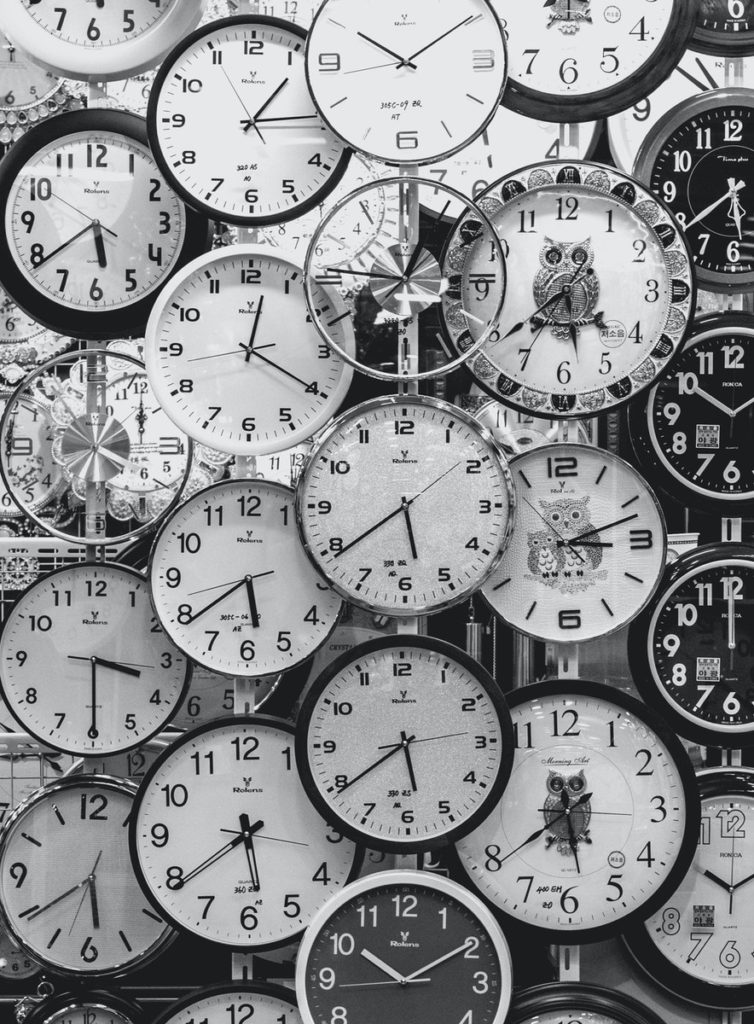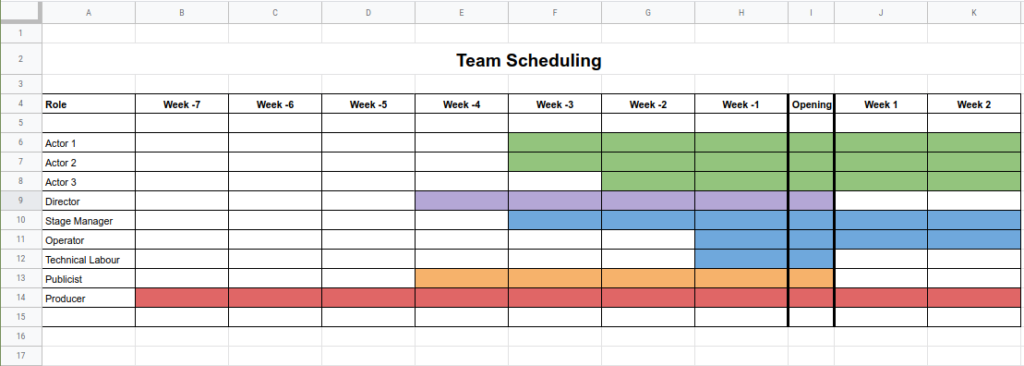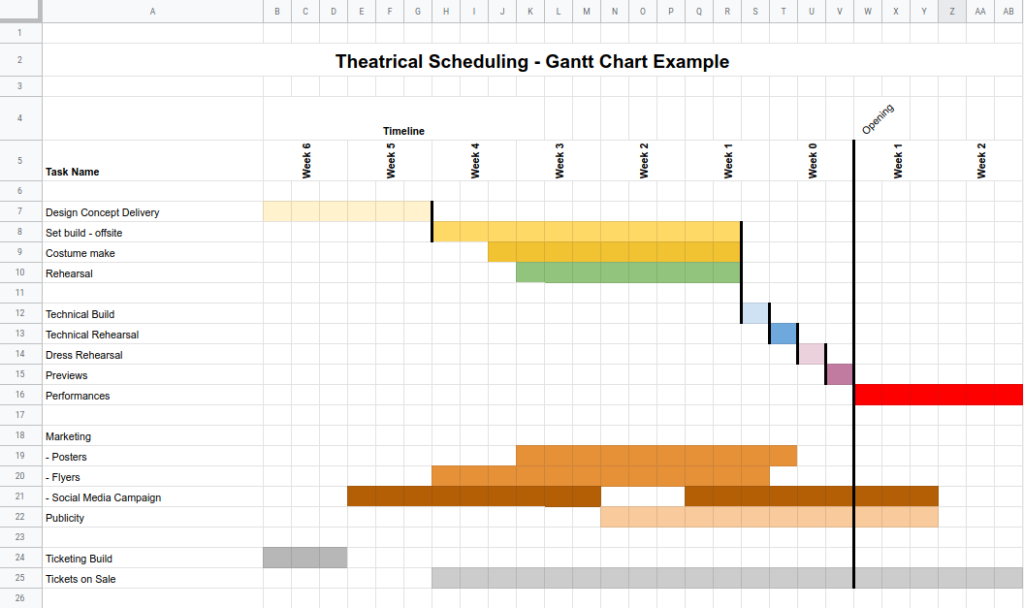
Building your theatre production schedule
Making a theatre production schedule is a crucial part of planning a staging your show. This article takes a look.
Introduction
Time is a vital part of planning your show. Often, a production fails based on having too little or even too much time. So to make sure you have the right amount of time, you’ll need to build a schedule.
The theatre production schedule is more important than most people understand. It is impossible to make an accurate budget without knowing your timings. In turn, the funds will define how much time you can afford.
At its most basic, a schedule is a calendar of the relevant events. You’ll need to plan for every element of the production. At first, these will be days, weeks and months. Later it will be hours and minutes.

Setting your zero-point
The first question in planning any production is, “When do you want to open?”
The reason planning begins here is that you need to anchor your project. So the opening night is the natural point everything is driving toward. On opening night, the show needs to be ready for an audience.
To begin with, you don’t need a firm date for opening night. All planning stems from how long before (or after) opening the event has to happen. Yet, if your whole schedule floats in time, it can only tell you so much, so set up the relationship to opening night, and once the final date is confirmed, you have your zero-point. Then, you can move the rest of the schedule accordingly.
Elements of a theatre production schedule
Next, you’ll need to identify all the tasks that make up your production. Don’t get too worried about actual dates at this stage. Remember, you start with a rough view and add more detail later.
List all the things you’ll need to do to open the production. Think about each task and make notes about how long it will take. You need to identify what you must complete before starting it, and the people required.
Common elements
Below is a list of elements that you’ll find in most schedules. These elements will help you create a draft.
Rehearsal
Estimate how much time you’ll need to rehearse your work. Base this on your experience from previous productions you’ve worked on. Your show will have its own specific requirements, but you can add them when you add detail.
Take a standard straight play as an example (non-musical, less than 5 characters). In my experience, this typically takes 3 weeks full time in the rehearsal room. But, of course, something more complex, like a classical play or musical, may take longer.
Creation
If you are devising or workshopping the script, you’ll need to allocate time for this in your schedule. This might allow you to cut your rehearsal time a little but take care to make time for each. Devising and rehearsing are not the same thing.
Technical Build
It takes this time to pack your production into the venue and prepare the technical elements. This time is usually without performers present. It may cross over with rehearsal room time.
You need to build the set and install the technical equipment during this time. It also includes time to focus lighting and tune the sound. Once you do this, the stage should be safe for performers to work on stage.
Technical rehearsal
This time allows technicians to weave the technical elements into the production. In addition, performers will need to be present to support the technical team.
The following are standard rehearsals during this time:
- Plotting – setting lighting, sound and other technical cue timing, level & quality
- Cue to cue – practising each technical cue with performers
- Technical rehearsal – like a regular run but stopping to fix technical errors
If you aren’t confident with how much time you’ll need, ask a stage manager or technician.
Dress Rehearsal
Make time for a few final rehearsals before you open to your audience. This is the last chance for the whole production team to polish anything not ready for the audience. You should run your final dress precisely like a performance.
Performances
Listing the number and timing of each performance. Also, consider what time the venue needs to open and close.
Moving out
Make sure you work out how much time you’ll need to get out of the theatre and when you’ll do it. A big push on closing night to get it done works well!
Marketing timeline
This shows when you need to post your advertising materials in public. That will define when to design and print them.
Schedule your people
Using the work done in the previous section, think about the roles you’ll need. When do they start, and how long will you need them? For example, you might use a performer for 6 weeks but the director 4 weeks and the operator 3.
Use this to make a guide that shows when you need each person. It helps as time goes on to know what dates you need people to be available for.

Deadlines
You need to work out the hard deadlines in your schedule. Fixed points in your plan help you keep the whole train on the tracks.
Some examples are:
- Final casting confirmation
- Sign off to print marketing material
- Rehearsal venue confirmed
- Funding confirmation dates
Assembling the jigsaw
Next, we move the pieces around to make the schedule. The opening night curtain is your primary anchor. As with a jigsaw, this date helps build borders that will give the schedule structure.
Take each task that needs to be completed and arrange it in relation to opening night. Some elements will rely on the completion of others. For example, you can’t begin rehearsal until you’ve cast the performers. So there is an inherent order.
Critical path
Each task may be dependent on the completion of another job before. In addition, some jobs will need you to complete multiple tasks. Therefore, you should now see strings of linked tasks on the completed schedule.
The longest one of these strings is what we call the critical path. This path is the least time required before you can open the show.
If there is any delay in completing any task on this path, you will not reach opening night in time. Other events not on this path may allow some flexibility but not in the critical path.
You now have the time it will take you to go from nothing to opening night. This is key to hiring staff, building a budget and scheduling your work. But, first, you need to know the critical path for your production.

Gantt charts
The traditional project planning tool for this is the Gantt chart. At first glance, a Gantt chart looks a bit like a bar chart rotated ninety degrees. Making one is a bit like a game of Tetris.
In the simplest terms, a Gantt chart is a visual representation of the schedule. Each bar represents a task and its size the length of that task. In addition, there are markers to connect events that depend on others. These elements combine to show the critical path.
Gantt charts are a simple tool and helpful in planning theatre. I recommend that you take some time to research how to build one. There are software packages out there to help you do it.
Availability of people and resources
You’ve got a draft schedule with a clear critical path but no fixed dates. This is helpful for planning, but it is only a draft until you lock it down.
Now you need to pay attention to when your resources are available. That’s your venue, people and critical equipment.
If you have a person who fits a role and isn’t available on the dates, can you move the production to serve them? The venue is only available on the first set of dates and can’t move. Do you choose the venue or the person?
This is now your challenge. Working with actual dates, you need to remake the schedule and look at your new critical path.
In most cases, ask, “what is the immovable object?” There will always be something that you cannot work around.
In my experience, this is usually the venue booking. Venues are almost always in demand, and if they offer you a slot, you have to fit into it or miss out. This means that pretty much everything is dependent on your venue booking.
The immovable object can be something else. If a critical performer can’t do those dates, you’ll need to find another venue or delay the production. Your goals for the production define what compromises you can make.
Locking it down
Your immovable object combines with your critical path to set your opening night.
From here, you can start weaving in other availabilities of people and resources. Each new person or resource will affect the critical path and the schedule in general. Your task has increased in complexity again.
You may find that this rules out using people or resources, and you’ll now have to search for alternatives. At worst, your date isn’t viable, and you go back a step. However, the earlier you can begin planning, the more likely you will lock down everything you need.
You can often ask venues to pencil in your planned dates. They will hold them until you are ready to confirm to make your scheduling easier.

Conclusion
Hopefully, this overview of theatrical scheduling has made the principles clearer for you.
Your theatre production schedule is an essential tool in getting your production on stage. It helps you plan your finances and muster resources at the right time. You can’t hire a team without locking it down, and it is crucial to show funders and other supporters you know what you are doing.
Taking time to design a clear schedule and find the critical path is something all producers need to become familiar with.
First time here? Visit our Welcome article to get started.